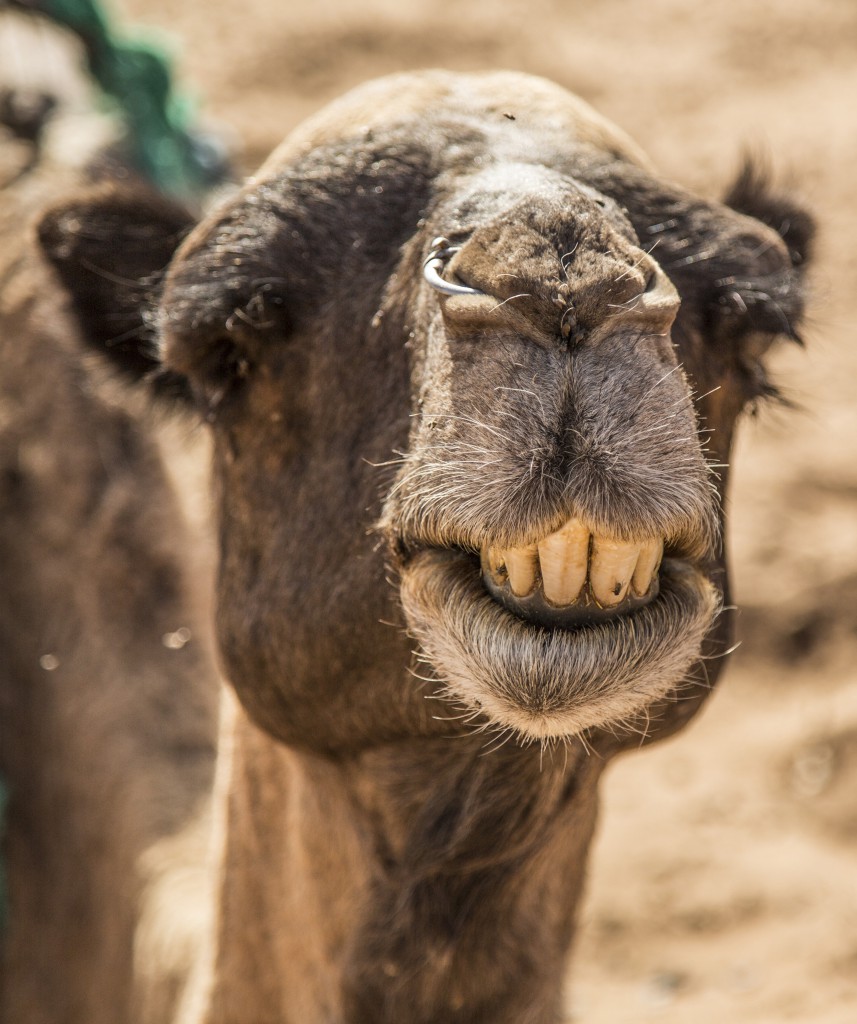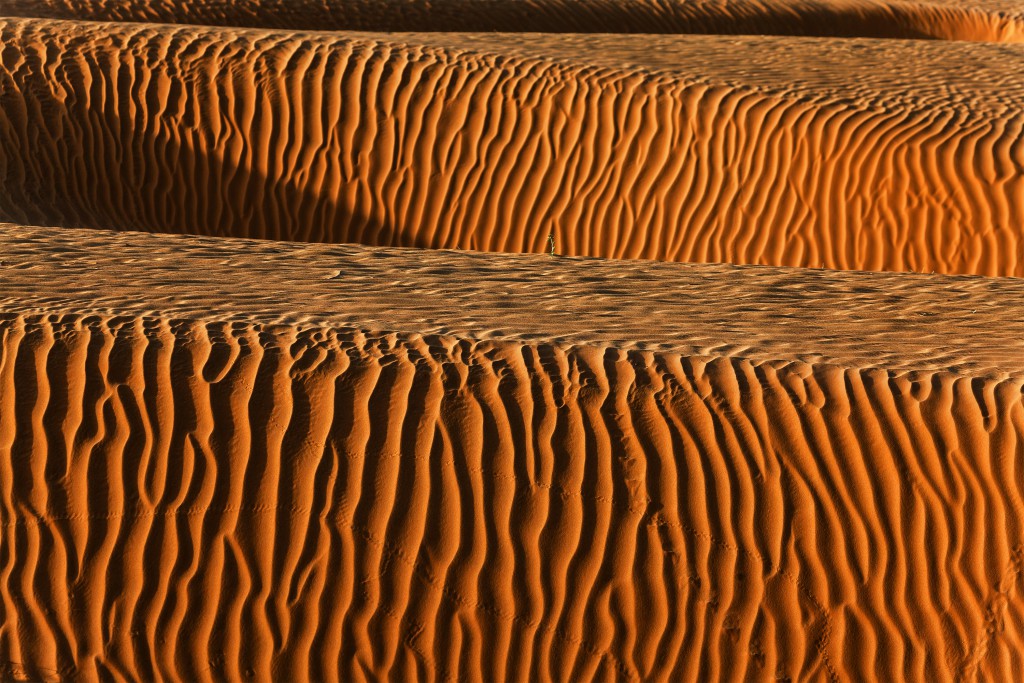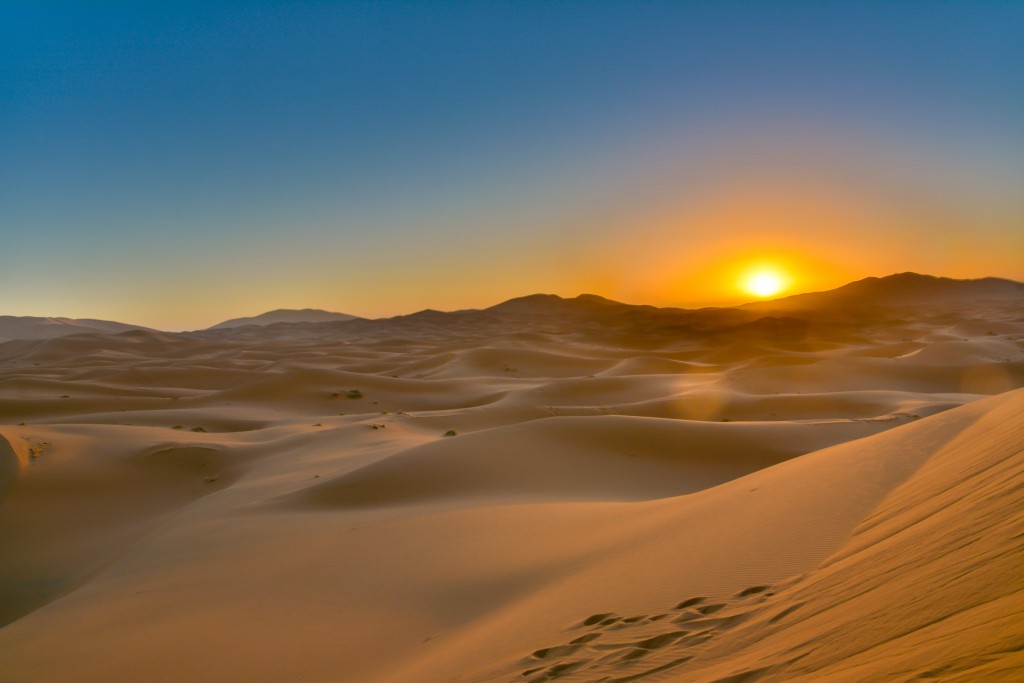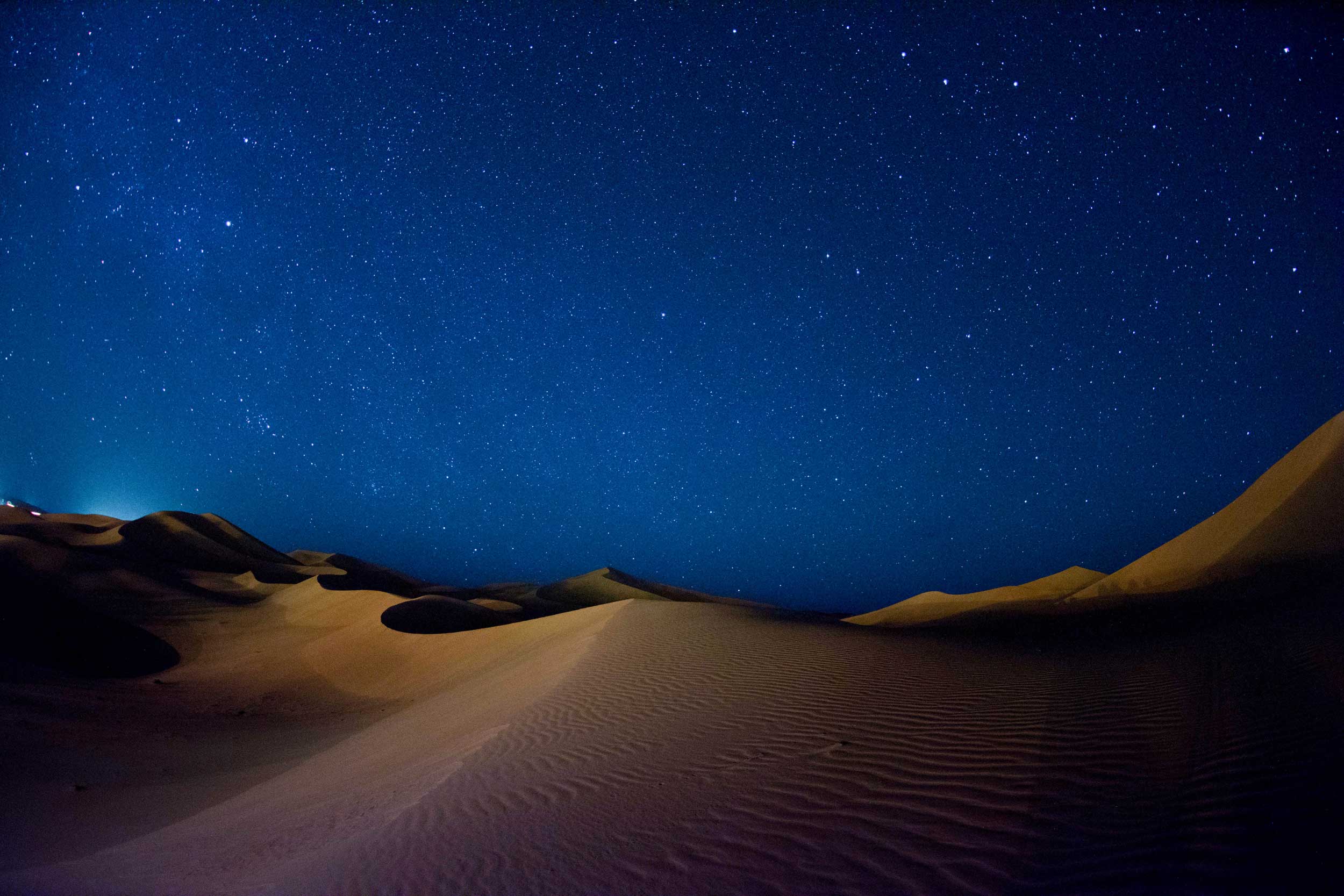The Humpback of the Sahara: Merzouga Camel Trekking
My clothes and I had a shower at midnight in the Sahara. Conscious of conserving precious water at our camp in the desert, I decided to combine my laundry and personal ablutions. I watched the ochre sand stream off my camel-riding regalia and run in rivulets down the plug hole.

I washed my hair last, lingering over the memory of the kind, young, dark-eyed Berber boy who had expertly wrapped his own purple shesh (turban) round my head and face because my flimsy Western scarf was no protection from the elements. Not that we needed any protection: the elements all behaved perfectly on our camel trek across the Merzouga Desert to watch the sunset and dine in the dunes.
We met our camels — or more accurately, single-humped dromedaries — at a base in the Merzouga after a 40 minute four-wheel-drive off-road trip, departing from the town of Rissani across a vast, barren reg, a stone desert pavement. Close up, the animals have the most quizzical faces, with large lips curved in a permanent smile, small hairy ears, bushy eyebrows, two rows of long curly eyelashes to shade and protect their eyes, and elongated nostrils that they can seal shut in a sandstorm. They look like comical caricatures of themselves.

Cleverly adapted to the desert environment, camels’ humps store fat and fluid which they convert to energy, giving them the ability to travel up to 160 kilometres without water. When they stop to drink, they can take on a staggering 130 litres of water in just a few minutes.
The stately creatures obligingly folded their knees on command, allowing us to climb on board. The species has a reputation for being bad-tempered and obstinate, but our camels were mild-mannered, patient and extraordinarily obedient. I wanted to bond with my mount, so was keen to know his name. My camel minder said the animals were nameless, but some had numbers. Unfortunately, mine had neither, so a version of the song about riding through the desert on a dromedary with no name (or number) was on constant replay inside my head as our tall ships made their stoic way up the steep dunes, led by a tribe of blue-clad Berber boys.
Having ridden many a horse, I expected to feel quite at ease, but the rocking-rolling motion was far more exaggerated than in horse riding, no doubt due to the camels’ long, gangly limbs and larger body mass. I had to hold on at all times to the sturdy handle attached to the front of the saddle — which made taking photos a bit of a challenge. Our camel boys obliged by running alongside, barefoot in the hot sand, taking dozens of images of the novices.
I was mesmerised by the tall graceful shadows we cast as our small caravan made its way up the sharp dune ridges, and fascinated by the prints left behind us by the camels’ thick footpads, which splay out as they walk, helping them navigate rough terrain and shifting sands.
The colours of the desert were chameleon — they played games with my eyes, constantly changing with the light and shadows. From a distance, the dunes appeared terracotta-red, but close up, the sand was ripe apricot, glowing in the late afternoon sun, and after dusk, a warm beige, the colour of the camels. Had it not been for their brightly-coloured passengers, the animals would have merged into the landscape, perfectly camouflaged.

As the sun began to fall from the bleached blue sky, we dismounted and climbed a short distance to the highest point on a sand dune mountain, just 55 kilometres from the Algerian border. It was slow going, uphill in the sliding sand: one step up, two down, collapsing in fits of laughter. The boys gallantly hauled the less able of our party up the slope, fearing we would miss the finale of the ‘show’.

Sunset in the desert is a spectacular phenomenon, a dazzling kaleidoscope of burnt orange, crimson and gold. I held my breath, transfixed as the blood-red orb slid behind the shimmering horizon in a final display of fire. Sitting on a hot sandy ridge in the Sahara, my thoughts skittered far away to another spell-binding sunset months earlier, high on a frozen mountain in Switzerland. Fire and ice: elements at opposite ends of the spectrum, but both with the power to hypnotise and all but paralyse me.
I found myself unable to move: I knew I would never pass this way again and wanted to savour every second. The heat radiating off the sand was intense, but when I buried my hands below the surface it was wonderfully cool. I felt somehow connected to this land of sand. After a gentle nudge that brought me tumbling back to reality, I reluctantly remounted the nameless one, and we plodded on to our campsite for dinner.
The surreality of the experience continued as our camels graciously knelt down outside what appeared to be a mirage. Here in the Sahara, almost invisible inside a necklace of sand dunes, was a luxurious tented enclave, with spacious private bedrooms and ensuite bathrooms surrounding a carpeted, open-air courtyard.
After freshening up, we sat around a campfire to be entertained by a troupe of highly-talented musicians and dancers from Senegal and Mali. We joined in the dancing, feeling clumsy and bumble-footed beside the tall, slim, elegant young men in their white and indigo robes.
Despite it being the height of the fast of the holy month of Ramadan, our charming hosts served us delicious hors d’oeuvres and a lavish three-course feast of Moroccan salads, tagine, couscous, and platters of fresh fruit, washed down with ice-cold beer and wine. Chilled rosé has never tasted so good as that night in the desert.
In accordance with their Muslim faith, none of our hosts, guides or the camel boys had had anything to eat or drink from sunrise until sunset, despite the extreme heat. I admired their fortitude but was relieved to see them finally break their fast after sunset and take long swigs of water from their flasks.

Later in the evening, we clambered up a sand dune behind the camp to do some serious star-gazing. I lay back on the sand, still warm from the sun, and scooped up handfuls of the primordial stuff, acutely aware of the sensation of the fine grains running between my fingers.
The moonless sky was an immense dark canopy studded with a myriad of brilliant diamantes. Once debate over the constellations on view had quietened down, the silence was complete and overwhelming — such a rare thing in this noisy world. Time stood still and I felt a deep sense of peace and serenity. It was an oddly spiritual, floaty, out-of-body experience that brought tears to my eyes, as though I had briefly touched another realm beyond the physical here and now.

Weeks later when I arrived home, grains of Sahara sand were still embedded in my camel-riding socks and shoes. I shook them out and kept the tiny bright granules in a little glass jar, a timeless memento of the desert. They sit beside a treasured 400 million year-old ammonite fossil I bartered for at a roadside stall en route to the Kasbah Xaluca Maadid, where we stayed after our camel trek.
The kasbah (fortress), with its palms, tennis courts, indoor and outdoor pools and tented pavilions, is a beautiful oasis in the barren reg. Located near Erfoud, ‘the door to the desert’, the hotel is constructed of adobe bricks, the traditional Moroccan building material. The huge suites are decorated with local treasures and artworks, and the lobby is furnished with magnificent ornate chairs, couches and tables, lovingly made by craftsmen from surrounding villages.
I fell in love with the adobe architecture of the region, dwellings constructed from the earth on which they stand. Made up of cubes, rectangles and castle-like towers, they sit so comfortably in the landscape that they are almost invisible. Some are deserted, crumbling gracefully back into the earth, leaving no ugly scars or skeletons behind like our Western equivalents. Nabil, our veteran local guide, told us about the historic city of Sijilmasa at the northern edge of the Sahara. Founded in 757 A.D., at its peak it was inhabited by 100,000 people, but it has all but disappeared, absorbed back into the earth whence it came.
Back in my lush, green homeland, I often think about the Sahara. It seems like a dream to have communed with the world’s largest desert, an expanse covering a staggering 9 million square kilometres. The mere mention of the word, derived from the Arabic sahra, meaning ‘desert’, evokes a flood of vivid sensory memories — visions of elongated shadows ascending shimmering apricot-red sand dunes, the smell of the shesh around my face, the sweet taste of figs and apricots in the tagine, the silky feel of the grains of sand, the absolute silence of the starry black night. But there’s another elusive dimension, a je ne sais quoi that flits away whenever I try to grasp or define it — like a mirage.
Take the Ancient Kingdoms Holidays tour of Morocco with The Innovative Travel Company, specialists in travel in Morocco.
For more information on Morocco, please visit Muchmorocco.com
